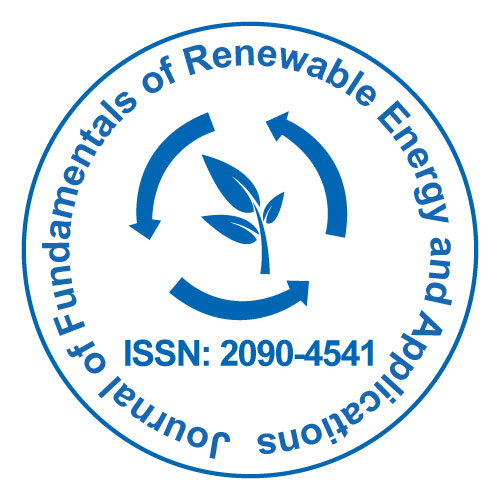
Journal of Fundamentals of Renewable Energy and Applications
Open Access
ISSN: 2090-4541

ISSN: 2090-4541
Commentary Article - (2024)Volume 14, Issue 4
Hydropower has long been one of the most reliable and efficient sources of renewable energy. As the world pivots toward more sustainable energy systems to combat climate change, hydropower plays a pivotal role due to its ability to produce clean electricity, store energy, and support grid stability. However, as global energy demands rise, the need for more efficient and effective hydropower systems has never been greater. Technological innovations are essential in improving the efficiency, capacity, and environmental sustainability of hydropower systems. These advancements range from the optimization of existing infrastructures to the development of new technologies that enhance energy conversion, operational flexibility, and reduce ecological impacts.
At the heart of any hydropower plant is the turbine, which converts the kinetic energy of water into mechanical energy, which is then converted into electrical energy by a generator. Advances in turbine design and materials are essential in increasing the efficiency of hydropower systems. One of the major limitations of traditional hydropower plants is their dependence on specific flow conditions to achieve optimal efficiency. Recent innovations in turbine design, such as the development of bulb turbines, Kaplan turbines, and Francis turbines, have focused on improving efficiency in low-flow conditions. Bulb turbines, for example, are designed for run-ofriver plants and can operate efficiently even in areas with lower water head (the height from which the water falls). The use of more adaptable turbines can help extract more energy from the available water flow, significantly increasing plant efficiency. Many hydropower plants still use older, less efficient turbines. Technological advancements in materials and design, including the use of composite materials for blades and components, have led to the development of high-efficiency turbines that can handle a wider range of water conditions. These turbines require less maintenance, have a longer operational life, and produce more energy from the same amount of water. By using more durable and efficient turbines, hydropower plants can enhance their energy output while reducing operational costs. Traditional hydropower plants use fixed-speed turbines, which operate at a constant speed regardless of water flow conditions. This approach often leads to less-than-optimal efficiency during varying water conditions. However, variable speed technology has emerged as an innovation to enhance turbine performance. Variable speed turbines can adjust their speed in real time based on the available water flow, optimizing energy conversion and improving overall plant efficiency. By allowing turbines to operate at their best efficiency point, plants can generate more power during periods of low water flow, improving both capacity and efficiency.
Hydropower plants, particularly those with reservoirs, are wellsuited for energy storage applications. By pumping water to higher elevations during periods of low demand and releasing it to generate power during peak demand, hydropower can provide pumped hydro storage. However, advancements in energy storage technology are pushing the boundaries of what is possible in hydropower. Traditional pumped storage facilities have been limited by their geographical location and the need for large-scale reservoirs. However, new approaches to pumped storage are emerging. For example, closed-loop pumped hydro systems, which do not rely on natural water sources, are being developed. These systems circulate water between two reservoirs, reducing environmental impact and making it possible to deploy pumped hydro storage in regions without suitable natural bodies of water. By reducing the environmental footprint and enhancing energy storage capacity, these innovations increase the efficiency and flexibility of hydropower as an energy storage solution. In addition to traditional pumped hydro storage, the integration of batteries with hydropower plants offers the potential for more responsive energy storage. Battery systems, such as lithium-ion and flow batteries, can store excess energy generated during times of peak water flow and discharge it during periods of low demand. This combination of hydropower and battery storage can create a more flexible and reliable energy system, ensuring that power is available when needed and reducing reliance on fossil fuel-based backup generation. One of the most exciting innovations in the hydropower sector is the development of hybrid power systems, which combine hydropower with other renewable energy sources, such as solar or wind, and integrate energy storage solutions. These hybrid systems can address the intermittency challenges of solar and wind energy by using hydropower as a reliable backup during periods when renewable generation is low. In this setup, hydropower acts as a flexible balancing mechanism, storing excess energy when renewable generation is high and releasing it when demand spikes or generation drops. While hydropower is considered a green energy source, it can still have significant environmental impacts, particularly in large-scale projects that involve dam construction and the flooding of vast areas of land. However, technological innovations are helping to minimize these effects and improve the sustainability of hydropower systems.
Enhancing hydropower efficiency through technological innovations is essential for maximizing the potential of this renewable energy source in the face of growing global energy demand. From advanced turbine designs and energy storage integration to environmental impact reduction and smart grid capabilities, technological innovations are enabling hydropower to operate more efficiently, flexibly, and sustainably. By continuing to invest in these technologies, the hydropower sector can contribute significantly to the global transition to a low-carbon, renewable energy future, helping mitigate the effects of climate change while supporting economic growth and energy security.
Citation: Hesse R (2024). Enhancing Hydropower Efficiency through Technological Innovations. J Fundam Renewable Energy Appl. 14:369.
Received: 27-Nov-2024, Manuscript No. JFRA-24-36239; Editor assigned: 29-Nov-2024, Pre QC No. JFRA-24-36239 (PQ); Reviewed: 13-Dec-2024, QC No. JFRA-24-36239; Revised: 20-Dec-2024, Manuscript No. JFRA-24-36239 (R); Published: 27-Dec-2024 , DOI: 10.35248/2090-4541.24.14.369
Copyright: © 2024 Hesse R. This is an open-access article distributed under the terms of the Creative Commons Attribution License, which permits unrestricted use, distribution and reproduction in any medium, provided the original author and source are credited.